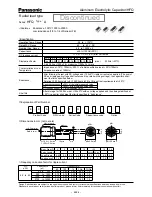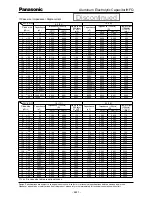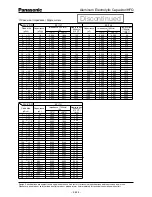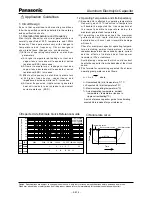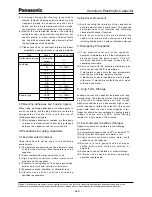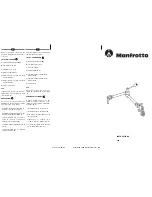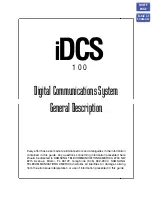
Design, Specifications are subject to change without notice. Ask factory for technical specifications before purchase and/ or use.
Whenever a doubt about safety arises from this product, please inform us immediately for technical consulation without fail.
Aluminum Electrolytic Capacitor
–
EE21
–
(3) A thorough drying after cleaning is required to
remove residual cleaning solvents which may be
trapped b e t w e e n the capacitor and the circuit
board. Avoid drying temperatures which exceed
the maximum rated temperature of the capacitor.
(4) Monitor the contamination levels of the cleaning
solvents during use by electrical conductivity, pH,
specific gravity, or water content. Chlorine levels
can rise with contamination and adversely affect
the performance of the capacitor.
✽
Please consult us for additonal information about
acceptable cleaning solvents or cleaning methods.
2.9 Mounting Adhesives and Coating Agents
When using mounting adhesives or coating agents to
control humidity, avoid using materials containing
h a l o g e n a t e d s o l v e n t s . A l s o , a v o i d t h e u s e o f
chloroprene based polymers.
✽
After applying adhesives or coatings, dry thoroughly
to prevent residual solvents from being trapped
between the capacitor and the circuit board.
3. Precautions for using capacitors
3.1 Environmental Conditions
C a p a c i t o r s s h o u l d not b e u s e d i n t h e f o l l o w i n g
environments.
(1) Temperature exposure above the maximum rated
or below the minimum rated temperature of the
capacitor.
(2) Direct contact with water, salt water, or oil.
(3) H i g h h u m i d i t y c o n d i t i o n s w h e r e w a t e r c o u l d
condense on the capacitor.
(4) Exposure to toxic gases such as hydrogen sulfide,
sulfuric acid, nitric acid, chlorine, or ammonia.
(5) Exposure to ozone, radiation, or ultraviolet rays.
(6) V i b r a t i o n a n d s h o c k c o n d i t i o n s e x c e e d i n g
specified requirements.
4. Emergency Procedures
(1) I f t h e p r e s s u r e r e l i e f v e n t o f t h e c a p a c i t o r
operates, immediately turn off the equipment and
disconnect from the power source. This will
m i n i m i z e a d d i t i o n a l d a m a g e c a u s e d b y t h e
vaporizing electrolyte.
(2) Avoid contact with the escaping electrolyte gas
which can exceed 100
°
C temperatures.
If electrolyte or gas enters the eye, immediately
flush the eye with large amounts of water.
If electrolyte or gas is ingested by mouth, gargle
with water. If electrolyte contacts the skin, wash
with soap and water.
5. Long Term Storage
Leakage current of a capacitor increases with long
storage times. The aluminium oxide film deteriorates
as a function of temperature and time. If used
without reconditioning, an abnormally high current
will be required to restore the oxide film. This current
surge could cause the circuit or the capacitor to fail.
Capacitor should be reconditioned by applying rated
voltage in series with a 1000
Ω
, current limiting
resistor for a time period of 30 minutes.
5.1 Environmental Conditions (Storage)
Capacitors should not be stored in the following
environments.
(1) Temperature exposure above 35°C or below 15
°
C.
(2) Direct contact with water, salt water, or oil.
(3) High humidity conditions where water could
condense on the capacitor.
(4) E x p o s u r e t o t o x i c g a s e s s u c h a s h y d r o g e n
sulfide,sulfuric acid, nitric acid, chlorine, or
ammonia.
(5) Exposure to ozone, radiation, or ultraviolet rays.
(6) V i b r a t i o n a n d s h o c k c o n d i t i o n s e x c e e d i n g
specified requirements.
3.2 Electrical Precautions
(1) Avoid touching the terminals of the capacitor as
possible electric shock could result. The exposed
aluminium case is not insulated and could also
cause electric shock if touched.
( 2 ) A v o i d s h o r t c i r c u i t i n g t h e a r e a b e t w e e n t h e
capacitor terminals with conductive materials
including liquids such as acids or alkaline solutions.
Type
Surface mount type
Lead type
Snap-in type
Series
V(
Except EB
Series
)
Bi-polar SU
M
KA
Bi-polar KA
FB
FC
GA
NHG
EB
TA
TS UP
TS HA
Cleaning permitted
L
L
L
(~ 100V)
L
L
L
L
L
L(
~ 100V)
L(
~ 100V)
L
L(
~ 100V)
L(
~ 100V)

